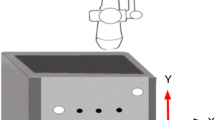Summary.
Background. In brain surgery, intraoperative brain deformation is the major source of postimaging inaccuracy of neuronavigation. For intraoperative imaging of brain deformation, we developed a platform for the integration of ultrasound imaging into a navigation system.
Method. A commercially available ultrasound system was linked to a light-emitting-diode- (LED) based neuronavigation system via rigid fixation of a position localiser to the ultrasound probe and ultrasound image transfer into the navigation system via a S-VHS port. Since the position of the ultrasound image co-ordinate system is not readily defined within the navigation reference co-ordinate system (REF CS), a transformation which links both co-ordinate systems has to be defined by a calibration procedure. Calibration of the ultrasound probe within the REF CS was performed via a cross-wire phantom. The phantom target was defined within the navigation co-ordinate system (by pointer under microscopic control) and imaged by ultrasound. Ultrasound presets were optimised (digital beam focusing, gain intensity) to attain a small echoic target for manual target definition. The transformation was derived from 150 ultrasound measures and iteration. Accuracy was calculated as mean linear error (LE; in XREF, YREF, or ZREF direction), overall mean LE (linear errors of all axes XREF to ZREF) and Euclidean error (EE; vectorial distance from the physical target).
Findings. Optimised ultrasound presets (8 MHz frequency, digital beam focusing, 20% gain intensity) enabled a low interobserver error (mean: 0.5 mm, SD: 0.28) for target definition within the 2-D ultrasound image. Mean accuracy of pointer-based physical target definition in the REF CS was 0.7 mm (RMSE; SD: 0.23 mm). For navigated ultrasound, the overall mean LE was 0.43 mm (SD: 1.36 mm; 95%CL: 3.13 mm) with a mean EE of 2.26 mm (SD: 0.97 mm; 95%CL: 4.21 mm).
Interpretation. Using a single target cross-wire phantom, a highly accurate integration of ultrasound imaging into neuronavigation was achieved. The phantom accuracy of integration lies within the range of application accuracy of navigation systems and warrants clinical studies.
Similar content being viewed by others
Author information
Authors and Affiliations
Rights and permissions
About this article
Cite this article
Jödicke, A., Springer, T. & Böker, DK. Real-time integration of ultrasound into neuronavigation: technical accuracy using a light-emitting-diode-based navigation system. Acta Neurochir 146, 1211–1220 (2004). https://doi.org/10.1007/s00701-004-0352-y
Published:
Issue Date:
DOI: https://doi.org/10.1007/s00701-004-0352-y




